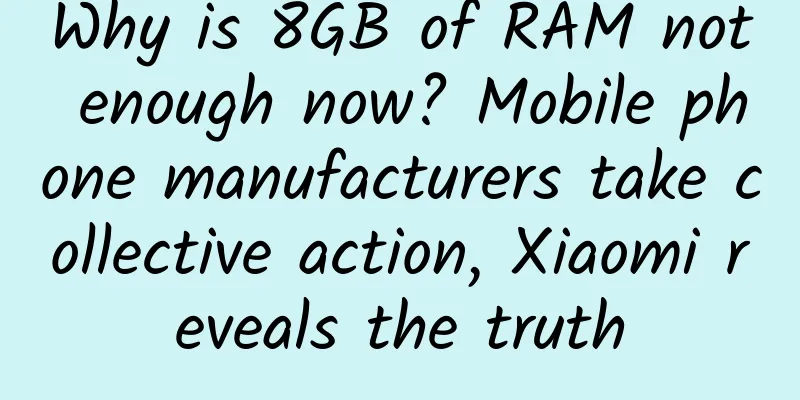Why is 8GB of RAM not enough now? Mobile phone manufacturers take collective action, Xiaomi reveals the truth

19GB RAM? Isn't that a bit crazy?Things don't seem to develop as we imagined. Just when we all thought that 8GB of RAM was already "excessive performance", mobile phone manufacturers are pursuing a higher performance ceiling. Ever since Huawei's Mate 40 series first introduced memory expansion technology in mobile phones and optimized 8GB to 10GB, major mobile phone manufacturers have responded one after another. With Xiaomi and Realme also joining the battle, memory expansion technology has become a standard feature of flagship mobile phones. What makes people laugh is that the competition between manufacturers is really everywhere, and everyone wants to prove that they are better than others. Huawei only integrated 2GB of memory at the beginning, and then vivo upgraded to 3GB. OPPO is even crazier, directly announcing that it supports up to 7GB of memory expansion, and the running memory can even be stacked up to 19GB - this is very exaggerated, you know, most laptops this year only have 16GB of memory as standard. Xiaomi's attitude towards new technologies is relatively stable, and it only supports the expansion of 3GB of RAM. The collective actions of mobile phone manufacturers make people wonder: why is 8GB of RAM not enough for Android flagship phones now? At the launch conference of Xiaomi MIX4, the MIUI team revealed the "truth". The average storage usage increased by 70%When introducing the enhanced version of MIUI12.5, Xiaomi specifically mentioned one point: According to data from Xiaomi laboratory tests, a certain chat software has added about 80 new features in the past two years, and the background memory usage has increased by nearly 67.9% compared to before. Someone once said: Many developers do not make apps, but "operating systems" and put all kinds of functions into them, which makes the apps more and more bloated. In fact, the functions of many apps are highly overlapping. If you don't believe it, you can try it now: open your phone and you will find that there are no less than 5 apps with "ride-hailing services". This is not an isolated case, but a common phenomenon. From a macro perspective, in 2021, the average background memory of APPs increased by 70% compared to two years ago. At this rate, by 2023, perhaps mobile phones with 8GB of RAM will really be eliminated. Mobile phone manufacturers are in an awkward situation, as the Android ecosystem is open. In the absence of effective constraints, mobile phone manufacturers cannot expect APP developers to be restrained in the face of interests, nor can they expect memory suppliers to sell at a discount, and they cannot expect users to understand the pressure of rising costs. In this context, memory expansion technology can be said to have come into being. It not only greatly alleviates consumers' "memory anxiety", but also allows mobile phone manufacturers to avoid running around to control costs, while also extending the service life of mobile phones. What is Memory Extension TechnologyHere comes the more important question: How is memory expansion technology implemented? Does the running memory "generated out of thin air" really make sense? Let me first state the conclusion: this is a very, very old technology, not a new selling point. In essence, it is no different from Windows' "virtual memory" and the "swap memory" on the M1 version of the Mac. The memory expansion technology used by Android phone manufacturers is also called "memory fusion technology", which is simply the fusion of memory and flash memory. In the flash memory used to store data, a part is "cut out" and used as running memory, thereby achieving the effect of increasing running memory. However, this approach has a natural disadvantage: the read and write performance of flash memory is far inferior to that of RAM. If the speed of LPDDR5 can reach 44GB/s, the speed of flash memory generally does not exceed 2000MB/s, which is more than 200 times the difference between the two. In other words, the RAM added by memory fusion technology can never be compared with the real hardware improvement. It is reasonable for Xiaomi to only support 3GB RAM expansion, because the biggest significance of this thing is: throwing inactive background applications into the virtual memory with lower performance, thereby reducing the real running memory usage and ensuring the smoothness of foreground application switching. I believe you will understand by now that the term "19GB" is a substitution of concepts - theoretically, Windows' virtual memory can be adjusted to twice the physical memory capacity, but can computer manufacturers say that 16GB of memory is 48GB of memory? Personal opinionFor domestic Android phones, the emergence of memory expansion technology does have a certain significance. Due to the incomplete push mechanism, most Android apps will choose to keep some threads in the background to push messages at any time. Apps that stay in the background do not need strong performance, but they will occupy capacity, which is a waste of hardware resources. From this perspective, "fused memory" reduces meaningless hardware waste and indeed extends the life of the phone. In short, 8GB RAM is not "not enough", but domestic Android phone manufacturers have found a cheaper solution to the current situation of RAM being abused by APP backgrounds - why use a sledgehammer to kill a nut? Don't you think so? |
>>: These 4 WeChat settings may leak your privacy every day, turn them off quickly
Recommend
Can it make "Halo" shake? "DESTINY" PS4 version game experience
Since Bungie was acquired by Microsoft in 2000, &...
Can you take the subway by just reaching out? This line makes it possible
No need to swipe a card or scan a code, just stre...
FLAC lossless collection of songs from 10 albums of the band Painful Worship
Founded in 1999, Miserable Faith is one of the mo...
Smart autumn harvest | Identify compound fertilizers and distinguish true from false at the speed of light
Produced by: Science Popularization China Author:...
How much does it cost to develop a watch mini program in Nagqu?
The main factors affecting the price of mini prog...
Qinling giant panda family has four generations living under one roof
In the past two days, the news that the Qinling g...
JD.com further deepens its five strategies to become the first channel in the home appliance industry
“To buy home appliances, go to JD.” Although this...
What skills are needed to develop and operate WeChat mini programs?
At the 2017 WeChat Open Class Pro Conference, the...
It took 270 hours to copy a classic sculpture. Can robots replace Michelangelo?
© Through Eternity Tours Leviathan Press: Michela...
How does Qianchuan plan to achieve explosive growth? How to make a popular Qianchuan short video?
Today, we will use a formula for creating a hit t...
How can you become a marketing expert without talent?
When you are engaged in marketing- related work, ...
Postpartum transformation training camp, 15 minutes a day for 30 days, let the beautiful mother glow with girlishness
Postpartum transformation training camp, 15 minut...
User operation: How to accurately operate push?
By actively pushing messages to users' mobile...
What are the "black and white holes" on the road? You can't just hide from them!
Tunnel entrance and exit sections Why do accident...







![[Dark Horse Prince] Quantitative Learning Dragon Limit Training Class July 2021 Intermediate Training Class Audio + Handouts](/upload/images/67cc26612e58c.webp)

